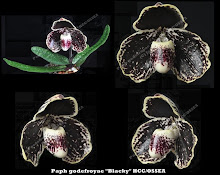The Genus Coryanthes belongs to Stanhopeinae and bears some of the most bizarre and intricate flowers in nature. There are about 60 species for this genus. They are pollinated by male orchid bees which collect fragrant substances which are said to be important for their mating.
Coryanthes macrantha is an Orchid from the genus of the Bucket Orchids. It is native to South America and the Amazon and grows as an epiphyte. It ranks amongst the strangest flowers in the whole of the plant kingdom let alone, the orchids. Whether one would consider it as beautiful or not, it is hard to not be amazed by it. Beauty is in the eyes of the beholder. Even at the bud stage it is clear that it is going to be no ordinary flower. At 80 mm, the flower is also much larger than any image would suggest.
They are shade growers and best exposed to indirect morning sun. They should be cultivated in baskets in a media that does not dry out quickly. Sphagnum moss is commonly used as the potting medium for water retention and acidity. I am using coarse bark top up with sphagnum moss. It is essential to hang the plants as the flower comes out from the side or the bottom of the pot and the long inflorescence. They are able to tolerate our tropical warm temperatures, fairly high humidity with good air circulation. They have fairly thin leaves that are prone to water loss. The plant is given water almost daily to keep them fairly moist.
They love to be fertilized but weakly and weekly at ¼ of the recommended strength. They share the same fertilizing regime as my Paphs.
The bud took about a month (25 days) to develop and “exploded” to complete opening over-night on the 25th day. It has a strong pleasant fragrance that combines antiseptic with spices and floral mint qualities. The plant was obtained a year ago with 2 pseudo bulbs but has since grown to 8 heads varying from 25 to 60 mm.
The above shows the development of the flower from the appearance of the inflorescence to fully exploded flower. The bottom two photos show from bud to fully exploded overnight








No comments:
Post a Comment